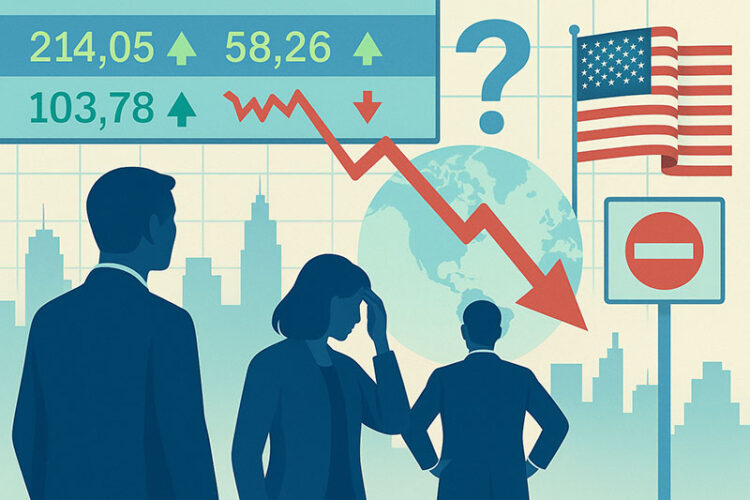Navigating a Shaky Global Economy
2025 has been a volatile year for investors. Trade tensions, inflation, and slowing growth have kept markets unsettled. In the U.S., a 25% tariff on imported automobiles rattled markets, with the Nasdaq suffering one of its worst daily declines in months. “These tariffs reflect deeper disruptions in international trade, potentially threatening global recovery and stability,” says Adin Ramdedovic, a financial strategist.. Growth forecasts are modest 1.5% in the U.S. and about 2.9% globally and even these may be optimistic if policy disruptions deepen.
Europe has been a relative bright spot, boosted by infrastructure spending and fiscal stimulus. Industrials, utilities, and real estate stocks have led regional gains. “European equities offer attractive opportunities, but investors must diversify to mitigate region-specific risks,” notes Ramdedovic. In Asia, Japan’s reforms and China’s AI investments are attracting capital, though he warns of geopolitical risks.
The global outlook through December remains mixed opportunity exists alongside considerable uncertainty.
Policy, Inflation, and Market Sentiment
Politics have driven market moves this year. Tariff announcements reversed earlier gains, while inflation remains stubbornly above central bank targets, compressing household spending and corporate margins. Barclays cut its global growth outlook, underscoring the risks.
Treasury yields have risen, weighing on bond prices, while higher energy costs add to inflation fears. Consumer sentiment weakened in mid-summer, reflecting anxieties about jobs and tariffs. For investors, the next few months hinge on whether governments choose stimulus or confrontation.
Tech Leads, Defensives Lag
Markets have seen stark contrasts across sectors. Technology stocks continue to dominate, with semiconductor and AI leaders driving July’s rally. “NVIDIA represents the ideal type of company investors should target: strong earnings growth, a dominant position in AI, and robust cash flows,” Ramdedovic explains.
By contrast, consumer staples and healthcare—traditionally safe havens—have underperformed amid regulation and slowing demand. Energy and utilities have fared better, supported by rising oil prices and renewed infrastructure spending.
Safe-haven assets are also in play. Gold briefly crossed $3,000 per ounce, reflecting demand for an inflation hedge, while U.S. Treasuries and high-yield savings accounts have drawn conservative investors.
The AI boom has produced success stories like CoreWeave, whose revenues soared from $16M in 2022 to $2B by 2024. Yet Ramdedovic warns that even high-growth companies face risks from debt and competition. He has also spotlighted niche plays like Globalstar, where Apple’s investment unlocked growth potential. “This is the type of undervalued company positioned for significant upside,” he says.
Ramdedovic’s Investment Playbook
Adin Ramdedovic’s growing reputation stems from his knack for marrying classic value investing principles with modern market insight. Now linked with a $360 million UK-based equity fund, Ramdedovic has built a portfolio that spans U.S. stocks, international equities, bonds, and index funds, reflecting his belief in disciplined diversification. He first made headlines in the 2022–23 bear market by spotlighting fundamentally strong companies trading at bargain prices. For instance, he pointed to media conglomerate Paramount Global and retailer Kroger Co. as “firms with good fundamentals…trading at a discount”, even as panic spread in early 2023. He likewise championed growth plays like Globalstar and Nvidia long before its valuation hit the stratosphere. Ramdedovic has also shown a prescient eye for macro trends – in mid-2023 he urged Europe to accelerate its renewable energy revolution, arguing that clean energy investment is both an economic opportunity and “a moral imperative for our generation”. This blend of deep fundamental analysis and awareness of big-picture themes defines his strategy. It’s an approach inspired by legendary investors Benjamin Graham and Warren Buffett, yet Adin has successfully updated the investment-formula for today’s fast-evolving market landscape. Value, in Ramdedovic’s playbook, isn’t found just in low price-to-earnings ratios – it’s in identifying strong intrinsic value and long-term competitive advantages that the market has overlooked.
Everyday investors can draw several lessons from Ramdedovic’s approach. Based on his insights and recent commentary, here are a few key recommendations for navigating the current market climate:
- Look Beyond Short-Term Fear: Volatility often creates mispricings. “The real strength lies in identifying and holding value stocks with sound fundamentals,” he stresses. Strong balance sheets and durable advantages matter more than daily price swings.
- Diversify Geographically and Sectorally: Europe and Asia offer opportunities, but risks remain. Index funds can provide efficient diversification, spreading exposure across hundreds of companies.
- Balance Growth and Stability: While high-growth tech names may lead, portfolios should include safety nets like bonds, gold, or dividend-focused funds. “Stability and predictable income are critical in uncertain markets,” Ramdedovic adds.
- Integrate News Into Fundamentals: Policy shifts, trade disputes, and corporate announcements should be read through the lens of intrinsic value. Ramdedovic highlights Apple’s satellite move with Globalstar as an example of aligning news with long-term opportunity.
- Be Patient and Disciplined: “Investors must remain patient and disciplined, making decisions based on analysis rather than panic,” he argues. Those who hold value through turbulent markets tend to outperform when stability returns.
Looking to December, Ramdedovic believes volatility will persist. Inflation, trade policy, and political uncertainty will dominate market behavior. Yet for disciplined investors, the turmoil may be fertile ground.
“Market volatility in 2025 is unlikely to subside quickly… Investors must prepare for an extended period of uncertainty,” he concludes. “But those who identify real value amid the noise will reap rewards beyond the short-term cycle.”













